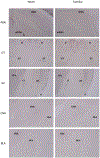Expression of c-Fos following voluntary ingestion of a novel or familiar taste in rats
- PMID: 36503889
- PMCID: PMC9795852
- DOI: 10.1016/j.brainres.2022.148177
Expression of c-Fos following voluntary ingestion of a novel or familiar taste in rats
Abstract
Taste neophobia, the rejection of novel tastes or foods, involves an interplay of various brain regions encompassing areas within the central gustatory system, as well as nuclei serving other functions. Previous findings, utilising c-Fos imaging, identified several brain regions which displayed higher activity after ingestion of a novel taste as compared to a familiar taste. The present study extends this analysis to include additional regions suspected of contributing to the neurocircuitry involved in evoking taste neophobia. Our data show increased c-Fos expression in the basolateral amygdala, central nucleus of the amygdala, gustatory portion of the thalamus, gustatory portion of the insular cortex and the medial and lateral regions of the parabrachial nucleus. These results confirm the contribution of areas previously identified as active during ingestion of novel tastes and expose additional areas that express elevated levels of c-Fos under these conditions, thus adding to the neural network involved in the detection and initial processing of taste novelty.
Keywords: Innate aversive response; Neophobic reaction; Rat; Unknown taste; c-Fos.
Copyright © 2022 Elsevier B.V. All rights reserved.
Conflict of interest statement
Declaration of Competing Interest The authors declare that they have no known competing financial interests or personal relationships that could have appeared to influence the work reported in this paper.
Figures


Similar articles
-
Novel tastes elevate c-fos expression in the central amygdala and insular cortex: implication for taste aversion learning.Behav Neurosci. 2003 Dec;117(6):1416-22. doi: 10.1037/0735-7044.117.6.1416. Behav Neurosci. 2003. PMID: 14674859
-
Taste neophobia and c-Fos expression in the rat brain.Brain Res. 2012 Apr 11;1448:82-8. doi: 10.1016/j.brainres.2012.02.013. Epub 2012 Feb 12. Brain Res. 2012. PMID: 22405689 Free PMC article.
-
c-Fos activity in the insular cortex, nucleus accumbens and basolateral amygdala following the intraperitoneal injection of saccharin and lithium chloride.Neurosci Lett. 2017 Apr 24;647:32-37. doi: 10.1016/j.neulet.2017.03.025. Epub 2017 Mar 18. Neurosci Lett. 2017. PMID: 28323090
-
Spontaneous recovery of a conditioned taste aversion differentially alters extinction-induced changes in c-Fos protein expression in rat amygdala and neocortex.Brain Res. 2007 Jun 4;1152:139-57. doi: 10.1016/j.brainres.2007.03.050. Epub 2007 Mar 23. Brain Res. 2007. PMID: 17442279
-
Neural substrates for conditioned taste aversion in the rat.Behav Brain Res. 1994 Dec 15;65(2):123-37. doi: 10.1016/0166-4328(94)90097-3. Behav Brain Res. 1994. PMID: 7718144 Review.
Cited by
-
Acute and chronic alcohol modulation of extended amygdala calcium dynamics.bioRxiv [Preprint]. 2023 Oct 10:2023.10.10.561741. doi: 10.1101/2023.10.10.561741. bioRxiv. 2023. Update in: Alcohol. 2024 May;116:53-64. doi: 10.1016/j.alcohol.2024.02.004. PMID: 37873188 Free PMC article. Updated. Preprint.
-
Acute and chronic alcohol modulation of extended amygdala calcium dynamics.Alcohol. 2024 May;116:53-64. doi: 10.1016/j.alcohol.2024.02.004. Epub 2024 Feb 27. Alcohol. 2024. PMID: 38423261 Free PMC article.
References
-
- Alden M, Besson JM, Bernard JF, 1994. Organization of the efferent projections from the pontine parabrachial area to the bed nucleus of the stria terminalis and neighboring regions: a PHA-L study in the rat. J. Comp. Neurol 341, 289–314. - PubMed
-
- Aggleton JP, Petrides M, Iversen SD, 1981. Differential effects of amygdaloid lesions on conditioned taste aversion learning by rats. Physiol. Behav 27, 397–400. - PubMed
-
- American Psychological Association, 2012. Guidelines for ethical conduct in the care and use of nonhuman animals in research. Washington DC: American Psychological Association.
-
- Arieli E, Gerbi R, Shein-Idelson M, Moran A 2020. Temporally-precise basolateral amygdala activation is required for the formation of taste memories in gustatory cortex. J. Physiol 598, 5505–5522 - PubMed
Publication types
MeSH terms
Substances
Grants and funding
LinkOut - more resources
Full Text Sources
Medical

